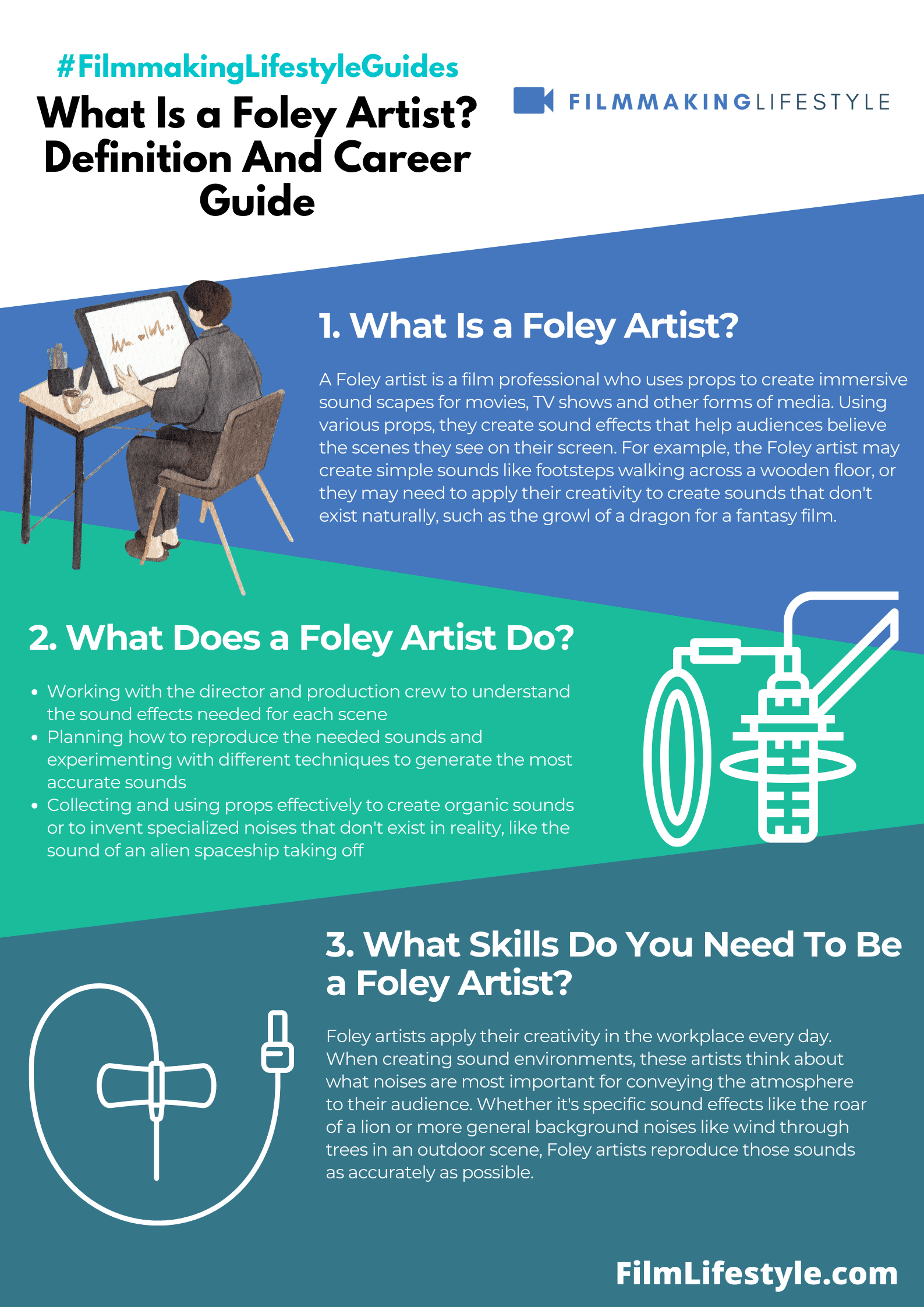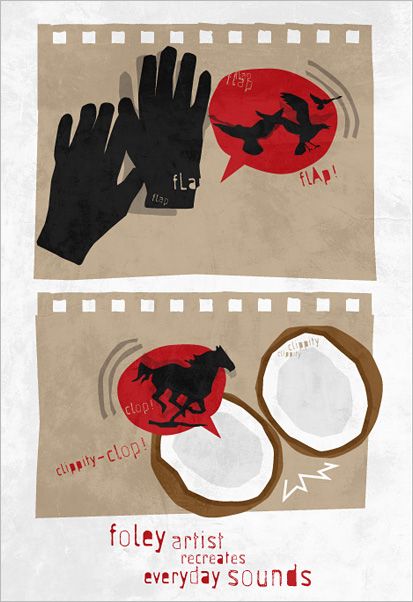Foley is a sound effect that mimics the physical act of various objects being pushed, rubbed, or scratched.
Foley artists are responsible for creating these sounds in movies and television shows.
The name comes from Jack Foley who was one of the first people to create these effects with his hands and feet on old movie sets.
Today, there are many different techniques used by foley artists including using a variety of props such as books, plastic bags, and sponges to simulate movement.
FOLEY ARTIST
What Is a Foley Artist?
The sound of a film is just as important to the storytelling process as any visual component.
Foley Artists work on set to create natural-sounding sounds that are necessary for scenes in movies or television shows.
They use various props, such as shoes, spatulas, and toy instruments, to recreate all the sounds you hear in your daily life.
Foley Artists are responsible for everything from footsteps to doors opening and closing.
They also have a knack for creating specific effects like breaking glass or rustling leaves with their hands and feet.
Ever watched a movie and wondered how the sounds of footsteps, rustling leaves, or clinking glasses come to life?
That’s the magic of a Foley artist, unsung heroes of the sound world.
These creative professionals are the ones adding depth and realism to the audio we take for granted in film and television.
In this article, we’ll jump into the world of Foley artistry, revealing how they shape the soundscape of our favorite media.
Get ready to uncover the secrets behind those background noises that make scenes pop off the screen.
The Role Of A Foley Artist
Creating authentic soundscapes in film requires a symphony of behind-the-scenes talent, and foley artists are crucial conductors in this auditory orchestra.
These skilled sound designers meticulously recreate the everyday sounds that actors’ movements would naturally produce.
By bringing these sounds to life, foley artists enhance the viewer’s immersion into the film’s world.
Foley is not a simple process of capturing noise; it’s an art that involves timing, precision, and creative problem-solving.
Foley artists must be able to match the timing and intensity of their sounds to the visuals onscreen.
They must also select the right props and surfaces to create sounds that feel genuine to the setting and action.
The specific tasks of foley artists can vary greatly depending on the needs of the film.
Here’s a glimpse into their responsibilities:
- Footsteps: Crafting the unique sound of a character’s walk based on their shoes and the various surfaces they tread upon,
- Clothing Rustle: Simulating the natural sounds of fabric during movement to convey a sense of realism,
- Prop Handling: Recreating sounds associated with objects the characters interact with, such as coffee cups, utensils, or weaponry.
Foley artists work in tandem with the sound editor and mixer.
It’s a collaborative effort to layer these recreated sounds effectively within the film’s audio track.
Their work helps to maintain the audience’s focus on the narrative rather than becoming distracted by a silent or sonically incongruous scene.
It’s important to appreciate the subtlety and skill involved in foley artistry.
A well-crafted soundtrack can often go unnoticed by the audience precisely because it so seamlessly integrates with the visuals.
As we jump further into the world of a foley artist, it becomes clear that their profound impact on filmmaking is both heard and felt – shaping not just the mood but also the texture of cinematic storytelling.
History Of Foley Art
The origins of Foley art reach back to the era of live radio drama, where sound effects were essential in bringing stories to life for listeners.
Artists would often perform sounds in real-time, a practice that paved the way for Foley techniques used in films.
When silent films transitioned to talkies with The Jazz Singer in 1927, the need for synchronized sound effects became apparent.
Foley artists emerged as unsung heroes, creating an auditory tapestry that made the on-screen action feel more authentic.
Jack Foley, a pioneer in the field, led the movement towards integrating live sound effects into film production.
His ingenuity and craftsmanship during the post-production of Show Boat solidified Foley’s position as a cornerstone of sound design.
The development of Foley artistry has been marked by numerous technological advancements.
From small soundproof studios to state-of-the-art digital equipment, the evolution has been striking –
- Quality microphones and recording devices capture the finest audio nuances.
- Digital audio workstations allow for precise editing and layering.
- Software plugins create expansive libraries of sound effects, but Foley artists maintain the human touch that’s critical for realism.
With the rise of digital filmmaking, the Foley profession continues to grow.
We find new challenges and opportunities in creating soundscapes that complement the visual elements and engage audiences around the world.
Techniques And Tools Used In Foley Art
We’ve observed that Foley artists employ a multitude of techniques and a wide array of tools to produce convincing, authentic sounds.
Their soundscapes become critical in bringing a scene to life.
To recreate the intimate sound of footsteps, a Foley artist might use different shoes and a variety of surfaces.
They work carefully to match the on-screen material – be it concrete, wood, or gravel.
Creating convincing fabric sounds is a meticulous process.
Foley artists often have a collection of cloths and garments to simulate everything from a whispering silk gown to the heavy rustle of a winter coat.
The props collection in a Foley studio is substantial.
Artists use items ranging from celery stalks for bone breaks to cooking pots for helmets.
They’re not afraid to get inventive.
For capturing these created sounds, quality microphones and state-of-the-art recording equipment are key.
They must ensure that every subtle nuance is picked up with absolute clarity.
To complement their palette of physical tools, Foley artists harness advanced technology:
- Digital audio workstations (DAWs),
- Sophisticated software plugins,
- Sample libraries for layering and achieving complex aural textures.
Editing is just as important in Foley as it is in visual effects.
Foley artists work hand-in-hand with sound editors to blend their creations seamlessly into the movie’s soundscape.
They pay close attention to timing and the minute details of sound.
We understand the importance of modern digital tools, yet we never underestimate the value of real, tangible sound-making.
It’s this unique combination that helps Foley artists continue to innovate and adapt to the demands of contemporary filmmaking.
Creating Realistic Sounds
Creating authentic audio illusions for film is at the heart of a Foley artist’s work.
To craft these aural experiences, they rely on an extensive array of tried-and-true techniques.
In films like Jurassic Park, the roar of the T-Rex wasn’t just any animal sound but a carefully orchestrated mix of various animal noises.
Similarly, Foley artists synthesize natural sounds using everything from household objects to specialized equipment.
Attention to Detail – every sound must be meticulously timed and fully aligned with the on-screen action.
For example:
- Footsteps: Different shoes and surfaces are selected to match the character walking on screen.
- Paper and Books: Handling noises are recorded with actual physical manipulation to sound believable.
Every rustle of clothing and clink of a glass is recorded with precision, reflecting the specific textures needed in the scene.
The rustle of silk, for instance, must sound distinct from the heavier swoosh of denim.
Microphone choice is crucial as it captures the nuances essential for realism.
Artists work with high-quality microphones positioned to catch the subtleties of each sound produced.

Layering is also key in achieving sonic depth.
Sounds are often layered to build complex audio backdrops that audiences subconsciously register as real-world environments.
Software and digital audio workstations aid in refining the captured sounds.
Foley artists and sound editors use plugins and sample libraries to enhance and manipulate sounds to new levels of authenticity.
Through this careful blending of technique and technology, we immerse audiences in the films they love.
Our craft brings the whispers of the wind and the thunder of engines to life, enveloping viewers in the vibrant soundscape that elevates cinematic storytelling.
The Importance Of Foley Art In Film And Television
Foley art is the unsung hero of the cinematic experience.
It breathes life into every frame, ensuring that the soundscape is as rich and vivid as the visual elements.
At its core, Foley art enhances the realism and emotional impact of the narrative, creating a connection that we, as the audience, might not consciously notice, but would certainly miss if it were absent.
It’s a crucial component that works in tandem with dialogue, music, and visual effects to form a cohesive auditory story.
Each sound we hear in Jurassic Park or The Lord of the Rings complements the tension and immersion on screen.
These sounds may seem minute, but they’re meticulously crafted to match the visual cues perfectly – the rustling of leaves as a dinosaur approaches or the clinking of armor as a knight prepares for battle.
Foley artists employ an array of techniques and tools, skillfully synchronizing their creations with the action to reinforce the narrative and the characters’ movements, elevating the viewer’s experience to a whole new level.
Here’s what we’re talking about when we refer to the indispensable nature of Foley:
- Realism – Foley adds authenticity to the scenes, making the fictional world convincing.
- Continuity – It maintains the audio continuity when production sound isn’t usable.
- Emotion – Subtle sounds can evoke strong emotional responses from the audience.
also, Foley plays a pivotal role in the post-production process.
The dedication behind closed studio doors results in sounds that are as indispensable as the cinematography.
Without Foley artists, scenes would feel hollow, and characters would lose a layer of connection with viewers.
We value the subtlety and intricacy Foley artists bring to the table, ensuring that every film moment feels grounded and true to life, whether it be the soft footfalls in a tense thriller or the dramatic crashes in an action-packed sequence.
What Is A Foley Artist – Wrap Up
We’ve uncovered the intricate world of Foley artists, the unsung heroes behind the sounds that bring films to life.
Their craft is an essential thread in the tapestry of movie-making, enhancing our viewing experience in ways we often take for granted.
Through their skillful blending of artistry and technical prowess, Foley artists ensure that every rustle, footstep, and movement resonates with authenticity.
As we close the curtain on this topic, let’s appreciate the layers of sound that Foley artists weave, creating a richer, more immersive world for audiences to lose themselves in.
Frequently Asked Questions
What Is Foley In The Context Of Movies And Television?
Foley is the craft of creating live, custom sound effects for movies and television, enhancing realism and emotional impact through precise timing and creative problem-solving.
Who Are Foley Artists And What Do They Do?
Foley artists are professionals who reproduce everyday sounds for audiovisual media, such as footsteps, clothing rustles, and handling of props, to add depth and authenticity to the sound track.
Why Is Foley Considered An Art Form?
Foley is considered an art due to the nuanced skill required to match sounds with onscreen actions and the creative approach needed to problem-solve and produce sounds that feel natural within the context of the scene.
How Do Foley Artists Contribute To A Film’s Audio Track?
Foley artists contribute by carefully syncing reproduced sounds with the actions on screen, which are then layered within the film’s audio track by sound editors and mixers to create a rich and believable sound environment.
What Impact Does Foley Art Have On The Audience’s Experience?
Foley art enhances realism, ensures audio continuity, and aids in evoking emotional responses, thereby creating a more immersive experience and connecting the audience more deeply to the scenes and characters.



